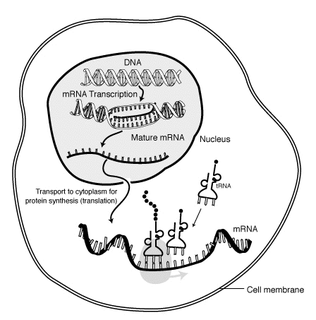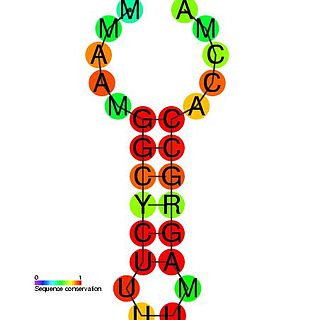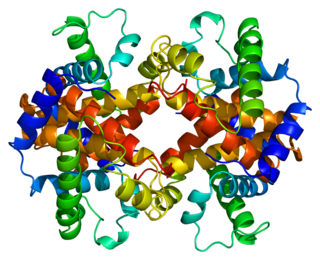This article may be confusing or unclear to readers.(August 2008) (Learn how and when to remove this template message) |
The C-rich stability element is a short part of a gene sequence important for the proper synthesis of globin and several other human proteins.

The globins are a superfamily of heme-containing globular proteins, involved in binding and/or transporting oxygen. These proteins all incorporate the globin fold, a series of eight alpha helical segments. Two prominent members include myoglobin and hemoglobin. Both of these proteins reversibly bind oxygen via a heme prosthetic group. They are widely distributed in many organisms.
Differences in the stabilities of individual mRNAs can dramatically affect the overall level of expression for genes. Eukaryotic mRNAs can have half-lives that vary from as short as several minutes to as long as several days. In differentiating human erythroid cells the deposition of high levels of alpha globin protein is dependent on an unusually long half-life of the alpha globin mRNA (greater than 24hrs). The stability determinant for alpha globin mRNA has been mapped to a pyrimidine-rich segment of its 3' UTR. This region confers stability by directing the assembly of a specific alpha ribonucleoprotein complex at this site. Subsequently Holcik and Liebhaber identified three other highly stable eukaryotic mRNAs that assemble the alpha globin protein complex at homologous pyrimidine-rich regions within their 3'UTRs (rabbit lipoxygenase, rat tyrosine hydroxylase, and human alpha(I)-collagen).

In biology, a gene is a sequence of nucleotides in DNA or RNA that codes for a molecule that has a function. During gene expression, the DNA is first copied into RNA. The RNA can be directly functional or be the intermediate template for a protein that performs a function. The transmission of genes to an organism's offspring is the basis of the inheritance of phenotypic trait. These genes make up different DNA sequences called genotypes. Genotypes along with environmental and developmental factors determine what the phenotypes will be. Most biological traits are under the influence of polygenes as well as gene–environment interactions. Some genetic traits are instantly visible, such as eye color or number of limbs, and some are not, such as blood type, risk for specific diseases, or the thousands of basic biochemical processes that constitute life.
Pyrimidine is an aromatic heterocyclic organic compound similar to pyridine. One of the three diazines, it has the nitrogen atoms at positions 1 and 3 in the ring. The other diazines are pyrazine and pyridazine. In nucleic acids, three types of nucleobases are pyrimidine derivatives: cytosine (C), thymine (T), and uracil (U).

In molecular genetics, the three prime untranslated region (3'-UTR) is the section of messenger RNA (mRNA) that immediately follows the translation termination codon. An mRNA molecule is transcribed from the DNA sequence and is later translated into protein. Several regions of the mRNA molecule are not translated into protein including the 5' cap, 5' untranslated region, 3' untranslated region, and the poly(A) tail. The 3'-UTR often contains regulatory regions that post-transcriptionally influence gene expression.
ErEN cleavage site V -cccaacgggcccu—ccucccc—ucc/u alpha globin (HBA1 or HBA2, NM_000517.1) cccca-----cccu—cuuccccaa lipoxygenase (ALOX15, NM_001140) -ccca----gcccacuuuuccccaa alpha(I)-collagen (COL1A1, NM_000088) cucca---uccccu----ucuccaa tyroilsmochie hydroxylase (TH, NM_000360)
ycca 1–5 cccw 1–4 ucycc : consensus (Holcik and Liebhaber, 1997)
There is some debate as to the number and identity of trans-acting factors recruited to the C-rich element. However the alpha globin poly(C)-binding protein (alphaCP) is agreed to be the core constituent of what is known as the alpha complex. A 39Kda protein, the alphaCP has been shown to bind directly to the C-rich RNA signal. There are two alphaCP, alphaCP1 and alphaCP2. Studies suggest[ which? ] the complex may protect a site near the C-rich element in the alpha globin mRNA from the erythroid endonuclease (ErEN). As many of the protein components necessary for alpha globin stability complex appear to be widely expressed across species and cell types this mechanism of mRNA stabilisation is likely to be a general one. However, in the mouse the cis and trans determinants have diverged to some extent. The mouse sequence requirements are equally C and U-rich compared to the predominantly C-rich human element. Despite this shift the murine alpha globin mRNA is still as stable due to a complementary change in the specificity of the poly(C)-binding protein.
In the field of molecular biology, trans-acting, in general, means "acting from a different molecule". It may be considered the opposite of cis-acting, which, in general, means "acting from the same molecule".















